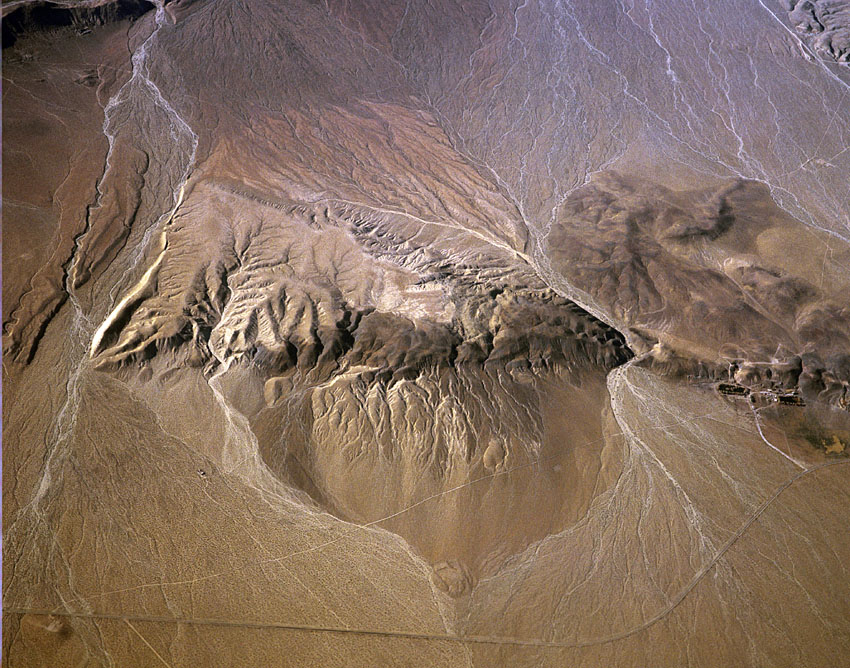The Fuji GW670II
Pictures were taken with a fully-mechanical non-electronic non-battery medium format (MF) Fuji GW670II. The Fuji is a fixed-lens construction and gives razor-sharp images. Basically it works like a 24x36mm Leica M3, it’s just the 6×7 cm film which gives superior image quality. You also need to set the aperture and time manually, both located at the lens. The lens also shows marks for the focus range at different apertures and the hyperfocal distance. The lens is very sharp at an aperture of 8-11, and images printed at 80 x 70 cm (app 32 x 27″) display a very good resolution. The 6×7 cm Fujifilm color slides of the GW670II are digitized and printed in a professional lab.
Picture out the of airplane’s window in the western US with the MF Fuji. Erosive debris from a mountain range.
… compared to DSLR
Large >60 cm sized prints of a full-frame Canon 5D Mark II 21 MP DSLR camera show much better resolution than that of 24×36 mm standard ISO100 film. The 6×7 MF seems to be slightly superior in terms of color range and resolution, but I feel differences are minor. Although technology moves forward, used DSLRs such as the 5Dii-FF (fullframe) introduced in 2008 nowadays are cheap second hand and still do the job. They are sturdy but chunky.
… digital APS-C range finders RF
While DSLRs are still bulky and heavy to carry to remote areas, digital RF bodies nowadays provide low weight high resolution option. The Sony A6000 fitted with an adapter from Novoflex allows to attach low weight super-quality lenses such as used Zeiss ZMs or Leica Ms. The Sony comes with a smaller than fullframe APS-C chip, having a slight lower depth of field (DOF) although that depends on the focal length and aperture. Each lens should be tested for color fringing before purchasing the lens.
Color fringing can be observed when shooting tourist signs or street signs. They show a good contrast of letters on the signboard. Shoot pictures from different locations and angles of that signboard. You easily note possible purple fringes. Manual focusing allows tag sharp pictures even in low light situations such as an exploding Stromboli volcano in southern Italy at night. Focus peaking and zoom-in functions are additional features ensuring sharp images. For fast moving objects the old manual-focus lenses offer the depth of field (DOF) scale. Although a nice, small, light-weight camera, shooting the camera manually is hard to manage due to small buttons.

A manual range finder (RF) lens allows to see the area in focus on the scale. Left: Shows the 2 (=2 meters) above the line going down towards the aperture 5.6. The 2.5 (meters) is beyond the lens’ smallest aperture of 16. Having set the aperture ring to 5.6, everything between 2 meters (from 5.6 on the left upwards along the white line towards the 2 on the distance scale) and about 2.2 meters (from 5.6 on the right upwards along the white line towards the distance scale). Right: Setting the hyperfocal distance means having everything in focus from x to infinity. x depends on the aperture; if the aperture is closed (= the aperture number is large) the hyperfocal distance (the distance of which everything is in focus) is large. However, small apertures cause diffraction of light on the lamellae of the aperture and thus unsharp images. Depending on the lens, best sharpness (and resolution) is between 5.6, 8 or 11. On the picture on the right, I set the lens to the hyperfocal distance for an aperture of 8 by turning the distance scale the infinity sign (the 90° flipped 8 right of the 15) above the aperture line of 8 (aperture) – that is within the white lines running upwards from the 5.6 and from the 11 (aperture). Looking at the left part of the lens on the right image, the aperture line of 8 is also located between 5.6 and 11. Moving upwards towards the distance scale it comes close to the 15 (meters). This with the hyperfocal setting for a set aperture of 8, everything between 15 m and infinity will be in focus for this lens. Overall, the scales thus allow to set the distance in focus before taking a picture; and one might be faster than autofocus if you know what and how to do it.
… micro4third cameras
This systems is small to carry anywhere and comes with excellent light-weight small lenses. The pay-off is a smaller sensor with a crop factor of 2. Panasonic’s G80 is light weight, water resistant and its controls are easy to manage manually. There are discussions on the performance of the small 4/3-chip (crop 2, vs APS-C crop 1.5). Indeed the crop of a 50mm f1.7 lens makes it a 100m f3.4. However, Panasonic’s small aperture lenses such as the 15 1.7 and 42.5 1.7 are powerful tools to blur the background and get a nice bokeh. Don’t forget some grey filters to make use of such lenses at sunlight, and with Doerr’s step-up there is no need to buy filters twice. Its only disadvantage is its power needs, thus don’t forget to take some additional batteries such as from Pantona.
… and point and shoot cameras
There are still only few point and shoot cameras on the market come with an APS-C chip. One of them the Sony RX with a low aperture of 1.8, offers manual aperture control, and comes with an integrated pop-up viewfinder. The latter I find essential in bright light.
